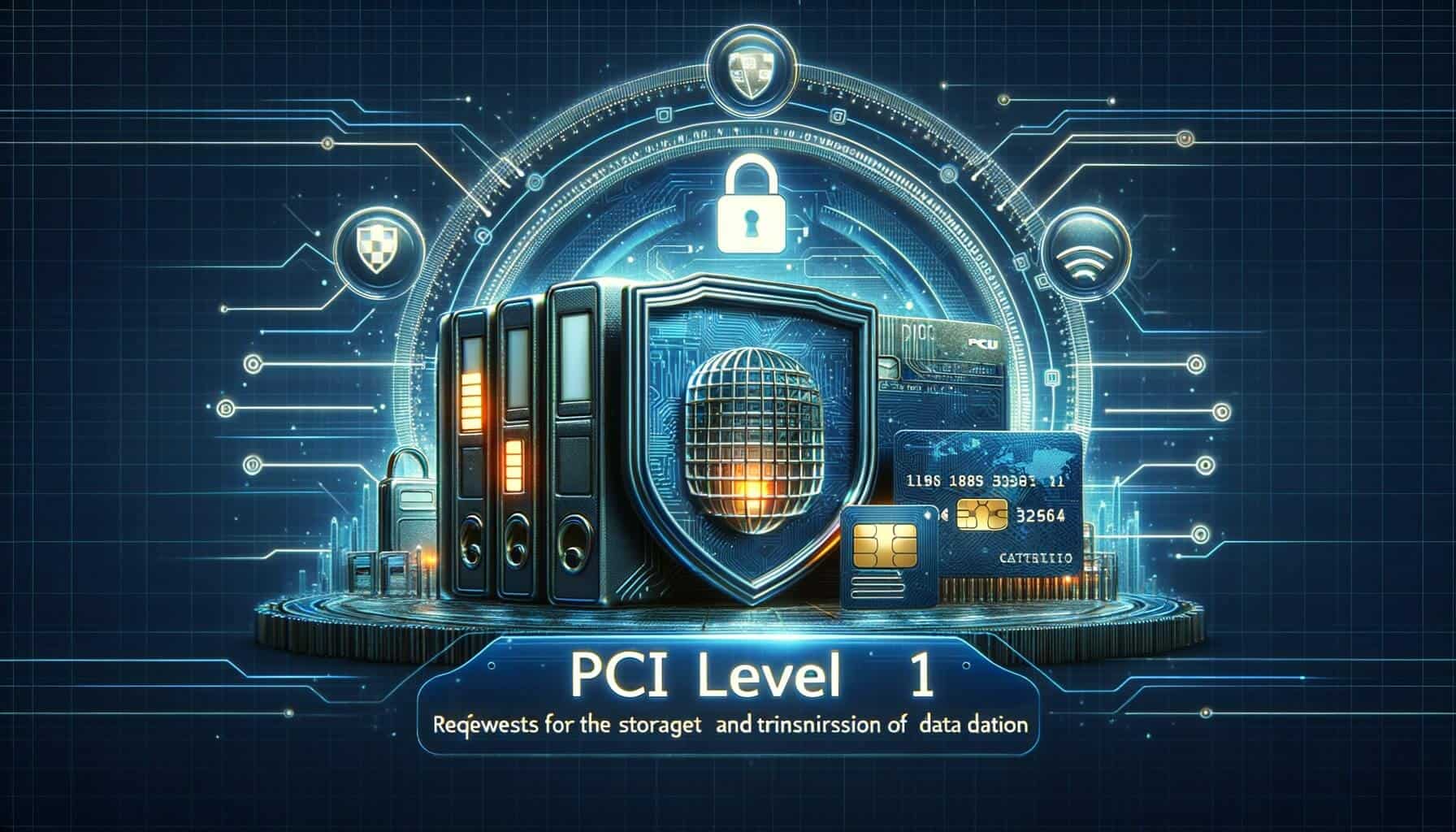
By Mollie Mills February 27, 2025
In today’s digital age, where online transactions have become the norm, ensuring the security of sensitive payment card information is of utmost importance. The Payment Card Industry Data Security Standard (PCI DSS) was established to provide a framework for organizations to protect cardholder data and prevent data breaches.
Within the PCI DSS, there are different levels of compliance, with PCI Level 1 being the highest and most stringent level. In this article, we will delve into the details of PCI Level 1 compliance, its requirements, and its significance for businesses.
Understanding the Payment Card Industry Data Security Standard (PCI DSS)

The Payment Card Industry Data Security Standard (PCI DSS) is a set of security standards developed by major credit card companies, including Visa, Mastercard, American Express, Discover, and JCB International. Its primary objective is to protect cardholder data and ensure the secure handling of payment card information during transactions. The PCI DSS applies to all organizations that store, process, or transmit cardholder data, regardless of their size or industry.
The PCI DSS consists of twelve requirements that organizations must meet to achieve compliance. These requirements cover various aspects of data security, including network security, access control, encryption, vulnerability management, and regular monitoring and testing. Compliance with the PCI DSS is essential for businesses to maintain the trust of their customers and avoid costly data breaches.
The Importance of PCI Level 1 Compliance for Businesses

PCI Level 1 compliance is the highest level of compliance within the PCI DSS framework. It is mandatory for organizations that process over six million card transactions per year or have experienced a significant data breach. Achieving and maintaining PCI Level 1 compliance is crucial for businesses for several reasons.
First and foremost, PCI Level 1 compliance helps protect cardholder data from unauthorized access and potential breaches. By implementing the necessary security measures and controls, organizations can significantly reduce the risk of data theft and fraud. This, in turn, helps maintain the trust and confidence of customers, who are increasingly concerned about the security of their personal and financial information.
Furthermore, PCI Level 1 compliance is often a requirement imposed by payment card brands and acquiring banks. Failure to comply with the PCI DSS can result in severe consequences, including fines, penalties, and even the termination of the ability to process payment card transactions. Compliance with PCI Level 1 not only ensures the continued ability to accept card payments but also demonstrates a commitment to security and compliance, which can enhance the reputation and credibility of a business.
Requirements and Criteria for Achieving PCI Level 1 Compliance

Achieving PCI Level 1 compliance requires organizations to meet all twelve requirements of the PCI DSS. These requirements are designed to address various aspects of data security and provide a comprehensive framework for protecting cardholder data. Let’s take a closer look at each requirement and the criteria for compliance.
1. Install and maintain a firewall configuration to protect cardholder data: Organizations must have a robust firewall in place to protect their network from unauthorized access. The firewall should be configured to restrict inbound and outbound traffic and should be regularly updated and tested.
2. Do not use vendor-supplied defaults for system passwords and other security parameters: Default passwords and settings are often known to hackers and can be easily exploited. Organizations must change all default passwords and configure security parameters according to best practices.
3. Protect stored cardholder data: Cardholder data should be stored securely using encryption and other appropriate security measures. Organizations must implement strong access controls and restrict access to cardholder data on a need-to-know basis.
4. Encrypt transmission of cardholder data across open, public networks: When cardholder data is transmitted over public networks, it should be encrypted using strong encryption protocols. Organizations must ensure that encryption is implemented for all sensitive data transmissions.
5. Use and regularly update anti-virus software or programs: Anti-virus software should be installed on all systems that handle cardholder data. The software should be kept up to date with the latest virus definitions and should be regularly scanned for malware.
6. Develop and maintain secure systems and applications: Organizations must implement secure coding practices and regularly update and patch their systems and applications to address any known vulnerabilities. Regular vulnerability scans and penetration tests should also be conducted.
7. Restrict access to cardholder data by business need-to-know: Access to cardholder data should be restricted to only those individuals who need it to perform their job responsibilities. Access controls should be implemented, and user accounts should be regularly reviewed and monitored.
8. Assign a unique ID to each person with computer access: Each individual with computer access should have a unique user ID to ensure accountability and traceability. User IDs should be securely managed, and inactive accounts should be promptly deactivated.
9. Restrict physical access to cardholder data: Physical access to areas where cardholder data is stored or processed should be restricted and monitored. Surveillance cameras, access control systems, and visitor logs can help ensure the security of physical environments.
10. Track and monitor all access to network resources and cardholder data: Organizations should implement logging mechanisms to track and monitor all access to network resources and cardholder data. Logs should be regularly reviewed for suspicious activity or anomalies.
11. Regularly test security systems and processes: Regular security testing, including vulnerability scanning and penetration testing, should be conducted to identify and address any weaknesses or vulnerabilities. Testing should be performed by qualified personnel or third-party vendors.
12. Maintain a policy that addresses information security for all personnel: Organizations must have a comprehensive information security policy that outlines the requirements and expectations for all personnel. The policy should be communicated, enforced, and regularly reviewed and updated.
Implementing Security Measures for PCI Level 1 Compliance
Implementing the necessary security measures to achieve PCI Level 1 compliance can be a complex and challenging process. It requires a combination of technical controls, policies and procedures, and employee training. Here are some key security measures that organizations should consider when working towards PCI Level 1 compliance.
1. Network Segmentation: Implementing network segmentation helps isolate cardholder data from other systems and reduces the scope of the PCI DSS requirements. By separating the cardholder data environment (CDE) from the rest of the network, organizations can minimize the risk of unauthorized access and potential data breaches.
2. Strong Access Controls: Implementing strong access controls is crucial for protecting cardholder data. This includes using strong passwords, implementing multi-factor authentication, and regularly reviewing and updating user access privileges. Access controls should be implemented at both the network and application levels.
3. Encryption: Encryption is a critical security measure for protecting cardholder data. Organizations should encrypt cardholder data both at rest and in transit. Strong encryption algorithms and protocols should be used, and encryption keys should be securely managed.
4. Regular Patching and Updates: Keeping systems and applications up to date with the latest patches and updates is essential for addressing known vulnerabilities. Organizations should have a robust patch management process in place to ensure that all systems are regularly updated.
5. Intrusion Detection and Prevention Systems (IDS/IPS): IDS/IPS systems can help detect and prevent unauthorized access and potential attacks. These systems monitor network traffic and can alert administrators to any suspicious activity or anomalies.
6. File Integrity Monitoring (FIM): FIM solutions monitor critical system files and configurations for any unauthorized changes. By regularly checking the integrity of files, organizations can detect and respond to any potential security breaches or unauthorized modifications.
7. Security Information and Event Management (SIEM): SIEM solutions collect and analyze log data from various sources to identify potential security incidents. By correlating and analyzing log data, organizations can gain insights into potential threats and take appropriate action.
8. Employee Training and Awareness: Employees play a crucial role in maintaining the security of cardholder data. Organizations should provide regular training and awareness programs to educate employees about their responsibilities and the importance of data security.
Assessing and Validating PCI Level 1 Compliance
Achieving PCI Level 1 compliance is not a one-time event but an ongoing process. Organizations must regularly assess and validate their compliance to ensure that they continue to meet the requirements of the PCI DSS. There are several methods and approaches to assess and validate PCI Level 1 compliance.
1. Self-Assessment Questionnaire (SAQ): The PCI Security Standards Council provides self-assessment questionnaires that organizations can use to assess their compliance. The SAQ consists of a series of questions that cover the requirements of the PCI DSS. Organizations must select the appropriate SAQ based on their specific circumstances and complete it honestly and accurately.
2. External Qualified Security Assessor (QSA): For organizations that process a large volume of card transactions or have complex systems, an external Qualified Security Assessor (QSA) can be engaged to perform an independent assessment. QSAs are certified professionals who have the expertise and knowledge to assess compliance with the PCI DSS.
3. Internal Audit: Organizations can also conduct internal audits to assess their compliance with the PCI DSS. Internal auditors should have a thorough understanding of the requirements and should be independent from the areas being audited. Internal audits can help identify any gaps or weaknesses in the organization’s security controls and processes.
4. Penetration Testing: Penetration testing involves simulating real-world attacks to identify vulnerabilities and weaknesses in the organization’s systems and applications. Penetration tests should be conducted by qualified professionals who have the necessary skills and expertise to identify potential security risks.
5. Vulnerability Scanning: Vulnerability scanning involves using automated tools to scan systems and applications for known vulnerabilities. Regular vulnerability scans can help identify any weaknesses or vulnerabilities that need to be addressed.
6. Quarterly Network Scans: Organizations that process a large volume of card transactions are required to conduct quarterly network scans. These scans help identify any vulnerabilities or weaknesses in the organization’s network infrastructure.
7. Attestation of Compliance (AOC): Once an organization has assessed its compliance, it must complete an Attestation of Compliance (AOC) to validate its compliance with the PCI DSS. The AOC is a document that confirms that the organization has met all the requirements of the PCI DSS.
Common Challenges and Pitfalls in Achieving PCI Level 1 Compliance
Achieving and maintaining PCI Level 1 compliance can be a complex and challenging process. Organizations often face various challenges and pitfalls along the way. Here are some common challenges and how to overcome them.
1. Scope Determination: One of the most significant challenges in achieving PCI Level 1 compliance is determining the scope of the cardholder data environment (CDE). Organizations must accurately identify all systems, processes, and people that handle cardholder data. This requires a thorough understanding of the organization’s infrastructure and data flows.
2. Legacy Systems and Applications: Legacy systems and applications can pose significant challenges in achieving compliance. These systems may not have been designed with security in mind and may lack the necessary controls and features. Organizations should assess the risks associated with legacy systems and implement compensating controls if necessary.
3. Lack of Resources and Expertise: Achieving PCI Level 1 compliance requires dedicated resources and expertise. Many organizations struggle with limited budgets and a lack of in-house expertise. Engaging external consultants or managed security service providers (MSSPs) can help bridge the gap and provide the necessary expertise and support.
4. Complexity of Requirements: The requirements of the PCI DSS can be complex and technical. Organizations may struggle to understand and interpret the requirements, especially if they do not have a dedicated security team. Engaging external experts or attending training programs can help organizations navigate the complexities of the PCI DSS.
5. Employee Awareness and Training: Ensuring that employees are aware of their responsibilities and trained in data security best practices is crucial for achieving compliance. However, many organizations struggle with employee awareness and training programs. Regular training sessions, awareness campaigns, and ongoing communication can help address this challenge.
6. Vendor Management: Organizations often rely on third-party vendors for various services, such as payment processing or hosting. However, these vendors can introduce security risks if they are not compliant with the PCI DSS. Organizations should have a robust vendor management program in place to ensure that all vendors meet the necessary security requirements.
Frequently Asked Questions (FAQs) about PCI Level 1 Compliance
Q1. What is the difference between PCI Level 1 and other levels of compliance?
A1. PCI Level 1 is the highest level of compliance within the PCI DSS framework. It applies to organizations that process over six million card transactions per year or have experienced a significant data breach. Other levels of compliance, such as Level 2, Level 3, and Level 4, have different requirements and criteria based on the volume of card transactions processed.
Q2. How long does it take to achieve PCI Level 1 compliance?
A2. The time required to achieve PCI Level 1 compliance can vary depending on the size and complexity of the organization. It typically takes several months to implement the necessary security measures, conduct assessments, and validate compliance. However, the process is ongoing, and organizations must continuously monitor and maintain compliance.
Q3. What are the consequences of non-compliance with the PCI DSS?
A3. Non-compliance with the PCI DSS can have severe consequences for organizations. Payment card brands and acquiring banks can impose fines, penalties, and increased transaction fees. In some cases, organizations may lose the ability to process payment card transactions altogether. Non-compliance can also result in reputational damage and loss of customer trust.
Q4. Can small businesses achieve PCI Level 1 compliance?
A4. Achieving PCI Level 1 compliance can be more challenging for small businesses due to limited resources and expertise. However, it is not impossible. Small businesses can leverage external consultants or managed security service providers (MSSPs) to help them navigate the requirements and implement the necessary security measures.
Q5. Is PCI Level 1 compliance a one-time event?
A5. No, achieving PCI Level 1 compliance is an ongoing process. Organizations must continuously monitor and maintain compliance to ensure that they meet the requirements of the PCI DSS. Regular assessments, testing, and updates are necessary to address new threats and vulnerabilities.
Conclusion
PCI Level 1 compliance is the highest level of compliance within the PCI DSS framework and is essential for organizations that process a large volume of card transactions or have experienced a significant data breach. Achieving and maintaining PCI Level 1 compliance requires implementing robust security measures, conducting regular assessments, and validating compliance.
While the process can be complex and challenging, it is crucial for protecting cardholder data and maintaining the trust of customers. By understanding the requirements and best practices for PCI Level 1 compliance, organizations can enhance their security posture and mitigate the risk of data breaches.